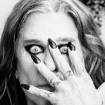By late 1979, Black Sabbath had kicked vocalist Ozzy Osbourne to the curb for being chronically wasted and were in the midst of recording their first album with former Rainbow chalice-hoister Ronnie James Dio. Meanwhile, in California, painter Lynn Curlee was exhibiting a series of paintings titled "Masque" at the Dunaway-O'Neill Gallery in Santa Monica, which was co-owned by actress Faye Dunaway. Among the paintings was a piece called Smoking Angels, which featured three female angels playing cards and puffing on cigarettes. Around this time, Curlee got a call from Warner Bros. Records. The label liked the cover painting he'd done for Blue Öyster Cult's 1976 album, Agents of Fortune, which coincidentally also featured playing cards. "They were in a jam," Curlee recalls. "Black Sabbath were releasing a new album called Heaven and Hell. The original cover-art plan was not working out, and someone decided to call me to ask if I had anything they might be able to use, since the timing was getting short." Curlee sent them a photo of Smoking Angels; Warner Bros. sent a check.

Released in early 1980, Heaven and Hell restored Sabbath's floundering reputation after the band's final two Ozzy-fronted full-lengths, the inferior Technical Ecstasy (1976) and meandering Never Say Die! (1978). Songs like opener "Neon Knights," "Die Young," and the title track would go on to become metal classics. Many fans assumed the cover art had been inspired by the tunes, but of course this was not the case, since Smoking Angels had been completed before Warner Bros. ever came calling. "The original idea for the painting came from a photo in a newspaper of some people backstage at a Christmas pageant," Curlee explains. "And I took the shape of the wings from photos of vultures eating a carcass."
All told, Smoking Angels took Curlee three weeks to complete. "It was done in acrylic on canvas, and measured about 4 by 6 feet," he says. "I work with standard brushes in a meticulous technique, with no airbrushing. Since the painting pre-existed, it didn't fit the square album format, so the right side had to be severely cropped. The original painting includes the entire wing of that angel."
The original painting was sold a few years later. "I think someone connected with the band in some way bought it, but I can't swear to it, since my business records from those days are long gone," Curlee says.
Although he was later commissioned by the manager of the Police to do a portrait of the band for a possible album cover, the painting wasn't used and thus Agents of Fortune and Heaven and Hell remain Curlee's sole contributions to the album-cover canon. Today he's an author and illustrator of children's books. "I was not a commercial artist or illustrator in those days," he explains. "I never sought that type of work, and I continued to show in galleries until I became an author-illustrator. The opportunity to do those two album covers literally fell into my lap.
"I actually consider Agents of Fortune to be the more successful cover artistically, since it was planned as an album cover, but Heaven and Hell is the one that has resonated with more people, partly because Black Sabbath was huge, and BÖC was not so much," he adds. "I am absolutely amazed by the success of the image. It has become my rock-and-roll claim to fame."
To see more of Lynn Curlee's work, go to curleeart.com












